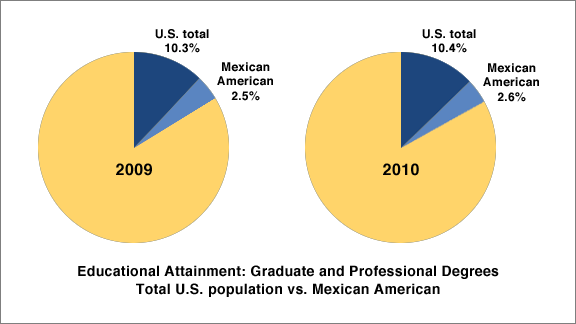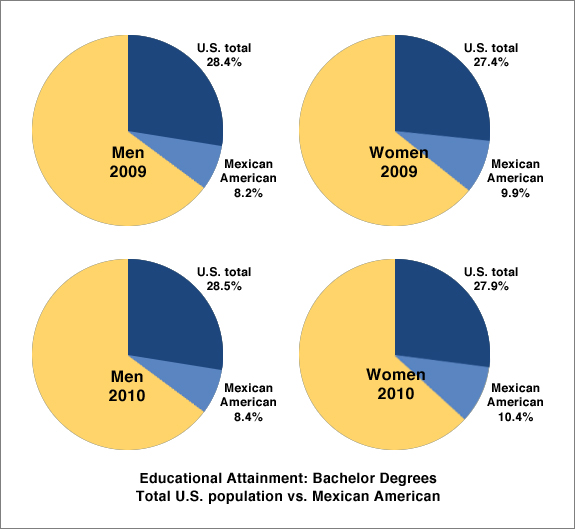

Magnificent Mexico New group sponsors blockbuster exhibit
El Paso Inc.
“Hosting exhibitions of Mexican art is of great significance both to residents of the Borderland and to the El Paso Museum of Art because approximately 86 percent of the area’s population are American nationals of Mexican descent. …
Link to article
Mother-Daughter Participation in a Community of Practice: Understanding the Sociocultural Mediation of the Identity/ies of Marginalized, 6th Grade Mexican-American Girls
R Reyes III
… introduce participants to how universities function; (3) a Career Day introducing participants to
possible fields of study and to professional Hispanic women who serve as role models; (4) a … The
purpose of this study is to understand how Mexican-American girls who have …
Link to article
Mexican American Mountaineer
M Brooks
… The diversity issue is often addressed during faculty development lectures to educate and sensitize
campus professionals. … Brooks/Mexican American Mountaineer 43 to engender a broader sense
of multiculturalism when teaching or researching topics for their classes. …
Link to article
Gender Roles and Substance Use Among Mexican American Adolescents: A Relationship Moderated by Acculturation?
S Kulis, FF Marsiglia… – Substance Use & Misuse, 2011
… school level influences on individual level risk and protective behaviors; gender and racial
inequities in professional careers; and … projects, studying risk and protective factors associated
with health and mental health outcomes among Mexican/Mexican American and American …
Link to abstract
Mexico woos health professionals, potential patients from US
Mexico woos health professionals, potential patients from US. By Deborah L. Shelton and Antonio Olivo, Chicago Tribune, MCT News Service. Created: …
Link to article
The Mexican-American Trial of Community Health workers (MATCH): Design and baseline characteristics of a randomized controlled trial testing a culturally tailored community diabetes self-management intervention
SK Rothschild, MA Martin, SM Swider, CT Lynas… – Contemporary Clinical …, 2011
… live in target communities to provide outreach and health education (5, 6) . Although trained and
supervised by health professionals, the value … This paper describes the design and implementation
of the Mexican American Trial of Community Health workers (MATCH), a blinded …
Link to abstract
Pay attention to Latin America
Pittsburgh Post Gazette
Mexico and Latin America then plunged down the list, displaced by the Middle East and South Asia. Those two regions remain on top of the heap today, in no small part because the Obama administration has continued the military-heavy tilt of US foreign
Link to article
Factors that influence mammography use and breast cancer detection among Mexican-American and African-American women
RZ Garcia, SC Carvajal, AV Wilkinson… – Cancer Causes and …, 2011
… promoting culturally appropriate messaging about the benefits and limitations of mammography,
education about breast awareness, and prompt reporting of findings to a health professional.
Keywords Mammography 4 Screening 4 Acculturation 4 Mexican-American 4 African …
Link to article
Arizona’s Ethnic Studies Needs No Defense: It Needs More Defenders
AlterNet (blog)
In coalition with barrio activists and some Mexican-American professionals, we fundamentally changed the educational, political, cultural and social landscape of Tucson and Arizona. Years later, few Tucsonans have had the vantage point and experience
Link to article
Hispanic grocers grab market share
SignOnSanDiego.com
“Instead of us being a Hispanic grocery store,” he said, “we’re a Hispanic grocery store that says: ‘Welcome to Mexico.’”
Link to article
RESULTS OF THE AMERICAN COMMUNITY SURVEY FOR 2010: a comparison of the total population of the United States and Mexican professionals
By HUMBERTO (TITO) GUTIERREZ
Edited by Carol Ponzio
Graphs by Mara Ann Fuller
The total population of the United States is 309,349,689.
The Mexican American population is 32,929,683, roughly about 11% of the total population.
The following are the results of a partial comparison of these two groups for professional occupations.
FOR EDUCATIONAL ATTAINMENT:
- The 2010 Graduate or professional degree was 10.4% for the total population.
- The 2009 Graduate or professional degree was 10.3% for the total population, a gain of .1% for the total population.
- The 2010 Graduate or professional degree was 2.6% for Mexican Americans.
- The 2009 Graduate or professional degree was 2.5% for Mexican Americans, also, a gain of .1%, however the gap is still 7.2% between the total population and Mexican American educational achievement in professional degrees.

These numbers have remained steady for the last two years, but when we look at the breakdown for men vs. women, the numbers are very different.
The 2009 number for male bachelor’s degrees or higher for the total population were 28.4% vs. 8.2% for Mexican Americans.
The 2009 number for female bachelor’s degrees or higher for the total population were 27.4% vs. 9.9% for Mexican American women. The difference between male and female for the total population in 2009 was in favor of males 28.4% vs. 27.4% for females. Males have a 1% advantage. In 2009 there was a 1.7% gap in favor of Mexican American females, 9.9% for women vs. 8.2% for men, a 1.7% advantage for women.
The 2010 number for male bachelor’s degree or higher for the total population was 28.5% vs. 8.4% for Mexican Americans.
The 2010 number for female bachelor’s degree or higher for the total population was 27.9% vs. 10.4% for Mexican Americans. The difference between male and female for the total population in 2010 was in favor of males, 28.5% vs. 27.9% for females, but the gap has narrowed to .6% between the genders, down from 1% in 2009. For Mexican American males the gap in 2010 is 8.4% vs. 10.4% for females, a gap of 2% in favor of females, which have gained from 1.7% in 2009 to 2.0% in 2010.

OCCUPATIONS: Male civilian employed 16 years and over:
- In 2009, management professional and related occupations results were: 32.6% for the total population, vs.12.2% for Mexican Americans.
- In 2010, management professional and related occupations results were: 32.8% for the total population, vs. 12.4% for Mexican Americans. The ratios have remained close for these groups. A gain of .2% by both groups, but Mexican American men are underrepresented by 20.4%, as compared with the total population.
OCCUPATIONS: Female civilian employed 16 years and over:
- In 2009, management professional and related occupations: total population, 39.1%, Mexican American, 21.4%.
- In 2010, management professional and related occupations: total population, 39.4%, Mexican American, 21.7%.
As a general statement the gap between the total population and women is narrower than with men. For women it’s only 17.7% instead of 20.4% for men. What is also of interest is the percentage of women vs. men in this group, which is 9.3% if favor of Mexican American women over Mexican American men.

INDUSTRY: Civilian employed population 16 years and older:
- In 2009, the results for professional, scientific, management, administrative and waste management services were 10.6% for the total populations vs. 10.1% for Mexican American.
- In 2010, the results for professional scientific, and management, and administrative waste management services were 10.6% for the total population vs. 10.1% for Mexican American population. The numbers have remained the same and are one area, which shows equality between the total population and Mexican American population.
For public administration:
- In 2009, the total population was 4.8% in public administration and 3.2% for Mexican Americans.
- In 2010, the total population was 5.2% in public administration and, 3.5% for Mexican Americans. This comparison shows that Mexican Americans lost .1% in this category.
SUMMARY
Ratios of professional employment have remained the same for the total population of the United States vs. the Mexican American population. To a large extent, Mexican American professionals remain underrepresented among professionals in general, but Mexican American women have gained ground in some areas.
Reference Documents from the U.S. Census Bureau
- Census Bureau, Selected Population Profile in the United States: 2010 (a PDF file)
- United States S0201. Selected Population Profile in the United States
Population Group: Mexican
Data Set: 2009 American Community Survey 1-Year Estimates
Survey: American Community Survey
Hispanic grocers grab market share
SignOnSanDiego.com
“Instead of us being a Hispanic grocery store,” he said, “we’re a Hispanic grocery store that says: ‘Welcome to Mexico.’”
Link to article
A Renaissance Is Coming For Mexican Manufacturing
Manufacturing Business Technology
… pool of IT professionals in the world—behind only the US in this hemisphere. … Government decisions by both the US and Mexican regimes will compromise …
Link to article
Phoenix Monsoon Still Ironing Out Details As Opening Night Approaches
SB Nation
There will be players — students and working professionals during the day, some locals, some from Africa, Brazil and Mexico — and they will make a …
Link to article
The Mexican Education War
The Nation.
I spent several days this week in Mexico City, on a trip for American journalists and policy professionals hosted by Groupo Salinas, the media, retail,
Link to article
Grant funds new program for Hispanics with bipolar disorder
San Antonio Express
Mental health professionals with UT Medicine San Antonio and … Three research programs will target Mexican Americans, who represent the majority of US …
Link to article
Latino Disconnect: La Doble Tanda y Cinema Tropical
Huffington Post
… about the great Mexican and Latin American stars of her time like Jorge Negrete, … by a selected group of critics, scholars and film professionals. …
Link to article
Exploring the perspectives and behaviors regarding help-seeking and knowledge about marriage and family therapy in 2nd and 3rd generation Mexican-American women
AM Barrera – 2012
… have also been identified which indicate that women seek professional mental health services
more frequently than men. The aim of this study was two-fold: (1) to provide an opportunity to
hear the voices of 2nd and 3rd generation Mexican-American women regarding their help
Link to abstract
Maternal Beliefs and Motivations for First Dental Visit by Low-income Mexican American Children in California
KS Hoeft, JC Barker… – Pediatric Dentistry, 2011
… by 3-years- old.8 These late visits may be in part due to financial barriers to access and dental
professionals’ reluctance to … among the highest rates of early childhood caries (ECC), even when
controlling for other variables such as income.16 Mexican American school children …
Link to abstract
Neuroticism, acculturation and the cortisol awakening response in Mexican American adults
D Mangold, J Mintz, M Javors… – Hormones and Behavior, 2011
… 21, 92-99. Cervantes, RC, Castro, FG, 1985. Stress, coping and Mexican-American mental health:
A systematic review. Hispanic J. Behav. Sci. … Costa Jr., P., McCrae, R., 1992a. Revised NEO
Personality Inventory (NEO-PIR) and NEO Five- Factor Inventory professional manual. …
Link to abstract


